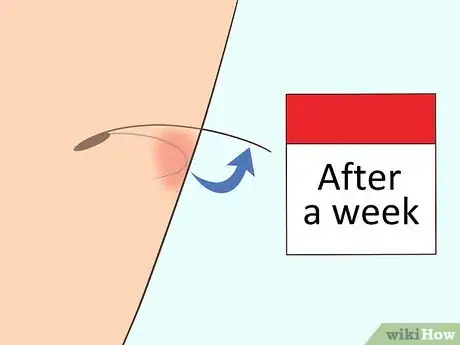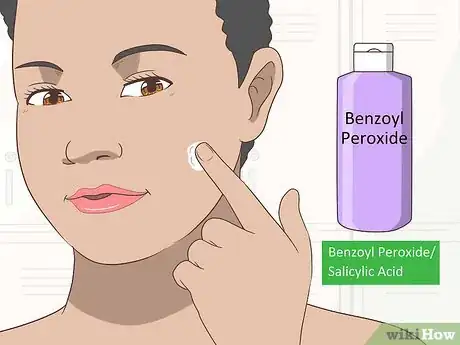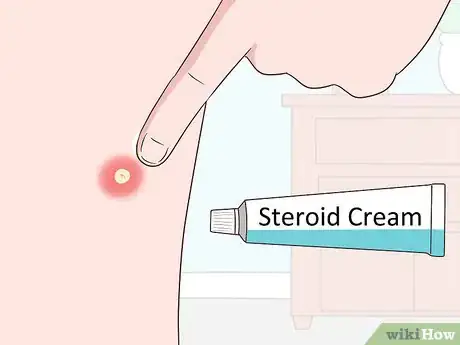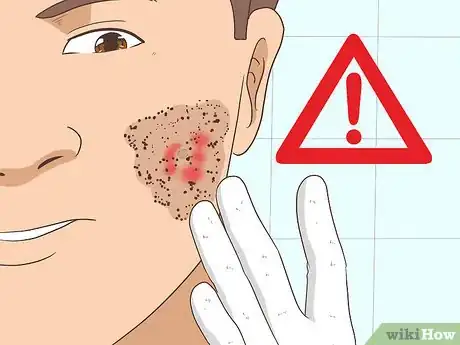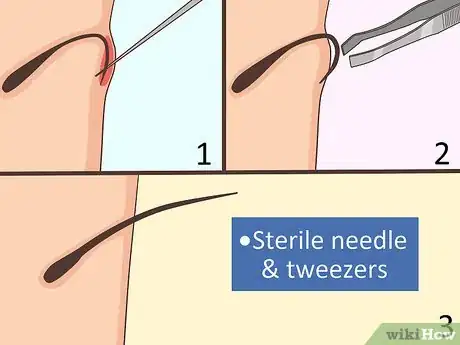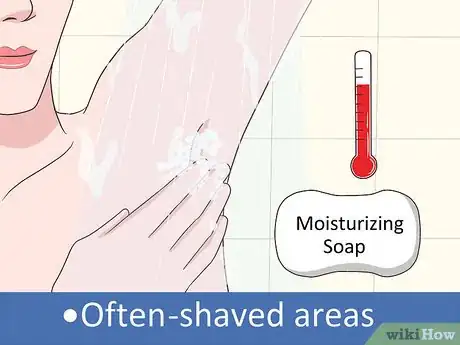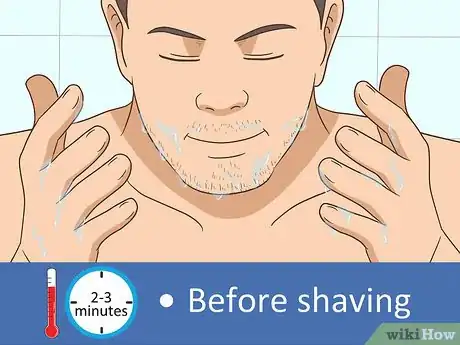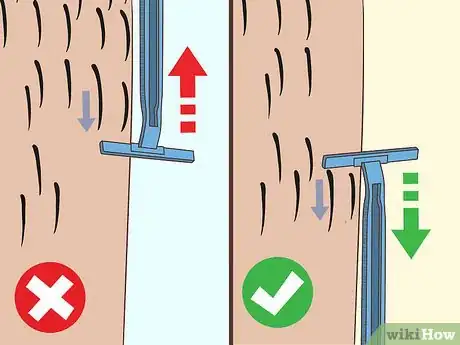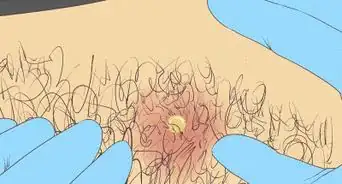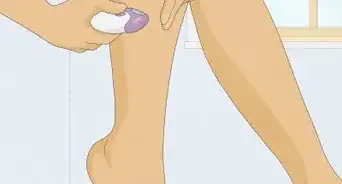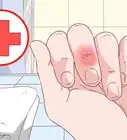This article was co-authored by Mohiba Tareen, MD. Mohiba Tareen is a board certified Dermatologist and the founder of Tareen Dermatology located in Roseville, Maplewood and Faribault, Minnesota. Dr. Tareen completed medical school at the University of Michigan in Ann Arbor, where she was inducted into the prestigious Alpha Omega Alpha honor society. While a dermatology resident at Columbia University in New York City, she won the Conrad Stritzler award of the New York Dermatologic Society and was published in The New England Journal of Medicine. Dr. Tareen then completed a procedural fellowship which focused on dermatologic surgery, laser, and cosmetic dermatology.
wikiHow marks an article as reader-approved once it receives enough positive feedback. This article received 12 testimonials and 100% of readers who voted found it helpful, earning it our reader-approved status.
This article has been viewed 11,082,294 times.
Ingrown hairs occur when hair curls around and grows back into the skin or if dead skin clogs the hair follicle and forces it to grow sideways. Ingrown hairs are often itchy and slightly painful. They look like small red dots on your skin, roughly the size of a pimple, and can become infected. Often, ingrown hairs will disappear on their own. If you have a stubborn ingrown hair, try loosening it with an exfoliator and a warm compress, and then pulling the hair loose with a pair of sterile tweezers.
Steps
Helping the Ingrown Hair Clear on Its Own
-
1Give the ingrown hair a week to clear up. In most cases, ingrown hairs will disappear without any intervention on your part. Typically, the ingrown hair will find a way to grow out through the skin that’s been blocking it. While waiting for the ingrown hair to clear up, do not pick or scratch at the ingrown hair.[1]
- While you’re waiting for the ingrown hair to disappear, avoid shaving over the bump. If you nick the area, you’ll risk infecting or worsening the ingrown hair.
-
2Apply a dab of acne medication to the ingrown hair. Ingrown hairs are pretty similar to pimples, especially when the ingrown hair is accompanied by pus. Apply benzoyl peroxide or salicylic acid several times a day for a few days. This, combined with daily exfoliation, is often enough to remove the ingrown hair since swelling will be reduced, giving the hair more room to grow out (rather than in).[2]
- You can purchase acne cream at any drugstore or pharmacy.
Advertisement -
3Apply a steroid cream to an infected ingrown hair. If your ingrown hair starts to fill with white or yellow pus, it’s infected. In this situation, before you remove the hair, you must treat the infection. Do this by rubbing a small dollop of steroid cream on the top of the infected skin. The cream will reduce swelling and help clear up the infection.[3]
- Some steroid creams—like cortisone—are available over the counter. For a stronger steroid, visit your doctor, and ask for a prescription to a steroid cream.
Extracting the Hair
-
1Exfoliate the area to remove the skin covering the ingrown hair. Twice a day, scrub the ingrown hair gently using an over-the-counter exfoliator or an exfoliating glove. This will help to remove any dead skin cells, dirt, and oils that might be trapping the ingrown hair. It may also physically nudge the tip of the hair out of your skin.[4] Try to hit the ingrown hair from a variety of directions, to loosen as much of the surrounding skin as possible.
- You can purchase an exfoliating scrub or a loofah glove at your local supermarket or at a drug store.
-
2Do not damage the surrounding skin through exfoliation. You'll need to exfoliate enough to loosen the skin covering the ingrown hair but shouldn't exfoliate so much that it damages your skin. If the area surrounding the ingrown hair becomes painful, looks raw, or starts to bleed, stop exfoliating immediately.
- When in doubt, exfoliate more gently but for a longer period. Say, 10 minutes.
-
3Apply a warm, moist washcloth to the area for a few minutes. Wet a washcloth with hot water, wring it out, and press it against the ingrown hair for 3-4 minutes. When the washcloth cools down, run it under hot water again. This will soften the skin and bring the ingrown hair to the surface, making it easier to pluck out.[5]
- If you can see the ingrown hair embedded in the skin, this treatment will soften the hair and bring it closer to the surface. If you can't initially see the hair, leave the washcloth on until it rises to the skin's surface.
-
4Tease the hair out of the skin using a sterile needle and tweezers. It may take a little time to coax the hair out, so persevere and do not cut the skin. Once you've exposed the tip of the hair with the needle, use a pair of sharp-tipped tweezers to pull the end of the hair out of the skin. Don't pluck the hair out completely if you can avoid doing so; just make sure that the ingrown end is out of the skin.[6]
- Sometimes you'll see a “loop” in the ingrown hair: the top of the hair where, instead of growing out through the skin, it curves over and grows down or sideways. This means that the tip of the hair has begun growing down into the skin. Try to pass the tip of a needle through the curve at the top of the ingrown hair and tug lightly. The end will often come loose.
- If you don't see the loop of the ingrown hair after exfoliating your skin and applying the warm washcloth, don't dig for the hair. You could damage your skin or draw blood.
- You can sterilize your tools by boiling them in water or by cleaning them with rubbing alcohol or running them through a hot flame until they turn bright red. If you heat them, let them completely cool before using them.
- Wash your hands before working on an ingrown hair and consider wearing nitrile gloves to prevent the spread of any bacteria.
Keeping the Skin Clear of Ingrown Hairs
-
1Wash often-shaved areas with warm water and moisturizing soap. Hairs are most likely to become ingrown in areas of your body that you shave often. So, keep these areas clean by washing them often. If you get ingrown hairs frequently, you can also apply an antiseptic to provide extra protection against infection.[7]
- You may also wish to apply a daily topical solution to prevent any further ingrown hairs from developing.
-
2Rinse the area you’ll shave with warm water before shaving. According to board-certified dermatologist Mohiba Tareen, "If you shave when your skin is dry, you’ll put yourself at a higher risk for getting ingrown hairs and skin irritation." So, rinse with warm water 2 or 3 minutes before shaving. You can also wash with a mild facial cleanser before you shave. When you apply your shaving cream, let it sit for another 2 or 3 minutes to soften the skin before you begin shaving.[8] Tareen also suggests "massaging the area in a circular motion before you shave—this helps bring the hair out of the follicle, so it will be less likely to curve back on itself, creating an ingrown hair."
- Apply a warm compress to the area, or even take a warm shower to help stimulate blood flow to the area.[9]
-
3Shave in the direction that your hair grows. While you can get a closer shave by shaving against the direction of hair growth, you’re less likely to get ingrown hairs if you shave in the same direction.[10] Board-certified dermatologist Mohiba Tareen also advises "making sure that the blade is sharp and new. A dull, overused razor will spread bacteria and leave a jagged edge on the hair, which could lead to more ingrown hairs." When you're finished shaving, Tareen suggests "applying a cool compress to your skin, which constricts the blood vessels and soothes the area."
- The longer and straighter the hair, the less likely it is to curl back into the skin, so try shaving less closely by using a single-blade razor or electric shaver instead of a multi-blade razor.[11]
Expert Q&A
Did you know you can get premium answers for this article?
Unlock premium answers by supporting wikiHow
-
QuestionWill it just go away?
 Marsha Durkin, RNMarsha Durkin is a Registered Nurse and Laboratory Information Specialist for Mercy Hospital and Medical Center in Illinois. She received her Associates Degree in Nursing from Olney Central College in 1987.
Marsha Durkin, RNMarsha Durkin is a Registered Nurse and Laboratory Information Specialist for Mercy Hospital and Medical Center in Illinois. She received her Associates Degree in Nursing from Olney Central College in 1987.
Registered Nurse
-
QuestionHow can I remove ingrown hairs from the back of my neck?
 Marsha Durkin, RNMarsha Durkin is a Registered Nurse and Laboratory Information Specialist for Mercy Hospital and Medical Center in Illinois. She received her Associates Degree in Nursing from Olney Central College in 1987.
Marsha Durkin, RNMarsha Durkin is a Registered Nurse and Laboratory Information Specialist for Mercy Hospital and Medical Center in Illinois. She received her Associates Degree in Nursing from Olney Central College in 1987.
Registered Nurse
Warnings
- Try not to squeeze the ingrown hair, or to “pop” it as you would a pimple. Squeezing can damage or break open the skin, which can infect the follicle.⧼thumbs_response⧽
- If the inflammation extends beyond the immediate area of the hair follicle or persists for more than a few days after the hair has been freed, consider visiting a dermatologist or your primary care physician.⧼thumbs_response⧽
Things You'll Need
- Clean washcloth and warm water
- Sterile needle-nose tweezers
- A small needle
- Moisturizer or moisturizing lotion
- Exfoliating cream
- Exfoliating loofah glove
- Topical antiseptic
- Rubbing alcohol
References
- ↑ https://www.nhs.uk/conditions/ingrown-hairs/
- ↑ http://www.businessinsider.com/the-science-of-why-you-should-treat-ingrown-hairs-pimples-2016-7
- ↑ http://www.businessinsider.com/the-science-of-why-you-should-treat-ingrown-hairs-pimples-2016-7
- ↑ https://everydayroots.com/how-to-get-rid-of-ingrown-hairs
- ↑ https://everydayroots.com/how-to-get-rid-of-ingrown-hairs
- ↑ https://everydayroots.com/how-to-get-rid-of-ingrown-hairs
- ↑ https://www.nhs.uk/conditions/ingrown-hairs/
- ↑ https://www.mayoclinic.org/diseases-conditions/ingrown-hair/symptoms-causes/syc-20373893
- ↑ Mohiba Tareen, MD. FAAD Board Certified Dermatologist. Expert Interview. 26 March 2020.
- ↑ https://www.nhs.uk/conditions/ingrown-hairs/
- ↑ Mohiba Tareen, MD. FAAD Board Certified Dermatologist. Expert Interview. 26 March 2020.
- ↑ https://www.mayoclinic.org/diseases-conditions/ingrown-hair/diagnosis-treatment/drc-20373898
About This Article
To remove an ingrown hair, start by gently exfoliating the skin around the hair using an over-the-counter exfoliating wash or an exfoliating glove. Then, hold a warm, moist washcloth over the ingrown hair for 3-4 minutes so it rises up near the surface of your skin. Next, use a sterile needle to expose the tip of the hair, but make sure you don't cut yourself. Finally, use a pair of sterile tweezers to pull the end of the hair out of your skin. To learn how to prevent ingrown hairs from forming in the first place, scroll down!
